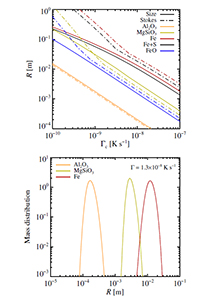Nucleation and growth of iron pebbles explains the formation of iron-rich planets akin to Mercury
- Details
- Published on 03 June 2022
Vol. 662
10. Planets and planetary systems
Nucleation and growth of iron pebbles explains the formation of iron-rich planets akin to Mercury

Mercury has a higher iron content than any other planet in the inner Solar System. The common explanation is that Mercury originally had a metal-silicate ratio similar to that of chondrite meteorites, but that early in its history it underwent one or several giant impacts that stripped away much of its crust and mantle, leaving the iron core as a major component. A difficulty with this "evaporation model" is that the relatively high abundance of moderately volatile elements in Mercury's mantle (e.g., K) precludes the occurrence of temperatures much higher than ~ 1000 K during its history. Johansen and Dorn propose here a completely different interpretation of Mercury's high iron content that invokes the separation of iron and silicates following the cooling of a gas with a solar composition in the inner part of the protosolar disk. They show that due to its high surface tension, Fe is prone to homogeneous nucleation under very high supersaturation (S ~ 10^5), leading to the formation of large iron pebbles on a sparse population of nucleated iron nanoparticles. In contrast, silicates (in the form of MgSiO3) reach smaller pebble sizes due to a much higher abundance of nucleated particles. As a consequence, the Stokes number of iron particles may be a factor of ~10 higher than that of silicates, which favors the preferential incorporation of iron in planetesimals through streaming instability filaments. The separation of Fe from the oxygen-bearing silicates may also explain why Mercury’s mantle has the lowest FeO fraction of all inner Solar System bodies, and the model, applied to the condensation of corundrum (Al2O3), can also account for the low Al/Si ratio in Mercury's crust. These ideas may apply as well to the growing population of iron-rich exoplanets, which are then not required to have experienced mantle-stripping impacts, but whose formation may be a natural consequence of temperature fluctuations in protoplanetary disks and the ensuing chemical !


